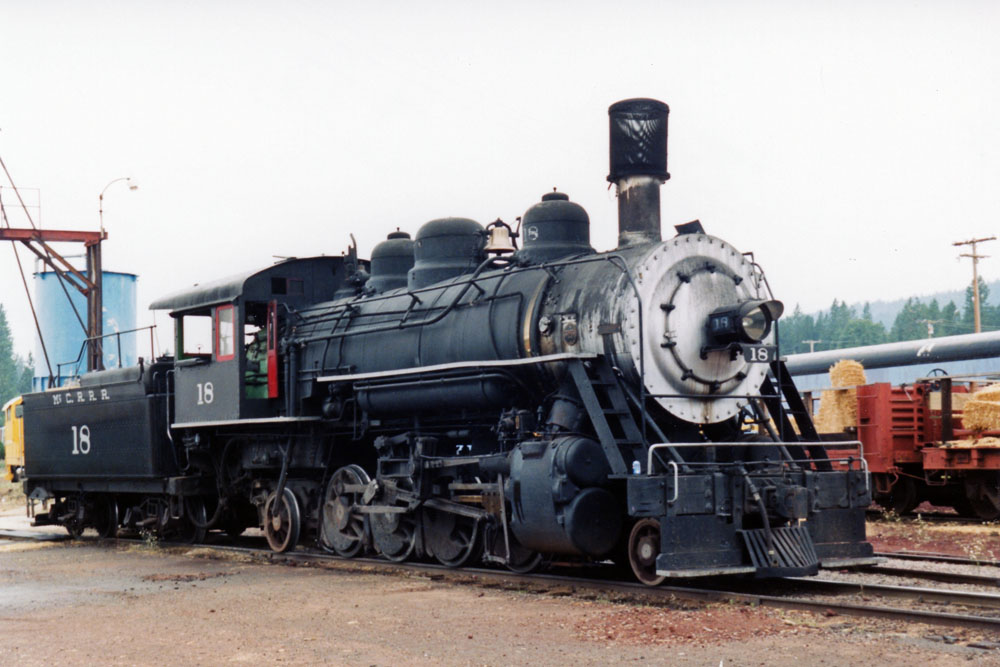|
McCloud River Railroad : Passenger Operations:
Steam Locomotive #18 |
|
|
 |
|
#18 in front of the McCloud shop. Roger Titus photo. |
|
|
The Panama Pacific Exposition held in San Francisco in 1915 celebrated the completion of the Panama Canal. The exposition was heavy on symbolism of connecting East and West. The organizers also wanted all major industries of California prominently featured, and to that end the two McCloud River companies joined forces with the neighboring Weed and Red River lumber companies to build an exhibit featuring the northeastern California pine lumber sector. Centerpiece of the exhibit was a house built entirely out of the products of the three sawmills or other products from the region, including a fireplace constructed from volcanic rocks. The McCloud River Railroad assembled a display train consisting of two newly completed flatcars loaded with prime examples of the finest old growth sugar pines the McCloud woods could grow, a new boxcar loaded with lumber produced by the McCloud mill, and a caboose specially constructed in the railroad's shops for the event. To "power" the display train the railroad turned to Baldwin, which at the time had a partially completed 90-ton Mikado on its factory floor. The Caddo River Lumber Company of Arkansas originally ordered the locomotive as their second #3, but their financing package fell apart shortly after Baldwin started construction. The McCloud River Railroad assumed the order as their #18, and Baldwin applied a special "Exposition Finish" to the locomotive upon its completion in November 1914. Baldwin shipped the #18 to San Francisco, where it joined the other cars sent south from McCloud. The completed train set remained on display throughout 1915, and the #18 finally reached home rails in January 1916 after the exposition closed. The #18 settled down to a long career of hauling logs and lumber over the McCloud River Railroad. A couple tender swaps and some modernization work detailed elsewhere on this site modified its appearance but kept it in top shape. The #18 ended up being one of three Mikados the railroad retained as backup power after dieselizing all mainline operations in 1953, though it apparently saw little if any service. In 1956 the neighboring Yreka Western bought the #18, where it rejoined the former McCloud River #19. The two Mikados powered the small road, including increasingly frequent railfan excursions, through the rest of the 1950s and into the 1960s. The #18's operating days came to an abrupt end in 1964 when it blew a cylinder head while powering a railfan excursion. The YW lacked the money or shop to effect repairs, and it would spend the next thirty-four years stored in the Yreka yards, usually partially to entirely covered with a tarp. YW's corporate parent Kyle Railways talked from time to time of restoring the #18 and sending it off to one of their other tourist railroads but never acted on those plans. In 1998 Kyle Railways decided to sell the Yreka Western, but decided to sell the #18 separate from the railroad. The McCloud Railway Company beat out at least two other bidders at the auction, and the #18 returned to McCloud in March 1998. Newspaper reports indicated McCloud Railway paid $80,000 for the #18, then invested another $350,000 over the next three years restoring it to service. The #18 steamed again for the first time since 1964 when it powered a trip with the #25 in February 2001, after which time it replaced the smaller locomotive in the steam program. The locomotive operated several times throughout the early 2000s, but growing financial problems forced the McCloud Railway to place the #18 up for sale in 2004. The railroad ran several announced "last runs" between the fall of 2004 and the summer of 2005, with the last of the last finally happening on Sunday, 7 August 2005. The Nevada Commission for the Reconstruction of the V&T Railway bought the #18 in January 2005 for eventual use on the part of the fabeled Virginia & Truckee they were in the process of rebuilding in western Nevada. The Commission leased the #18 to the Sierra Northern Railroad of Oakdale, California, and in April 2007 they loaded it onto a truck for shipment south. The #18 operated on the Sierra until moved to the Commission's trackage in the summer of 2010. After a short stay in Nevada the Commission loaded it onto a truck again, this time for delivery to the Fillmore & Western Railroad in southern California where it was used in filming the movie Water for Elephants. The #18 returned to Nevada after the filming, where it pulled passenger trains over the Carson City to Virginia City route up until the time its boiler certification expired in late 2015. The V&T shops completed an extensive rebuild in early 2020. |
|
|